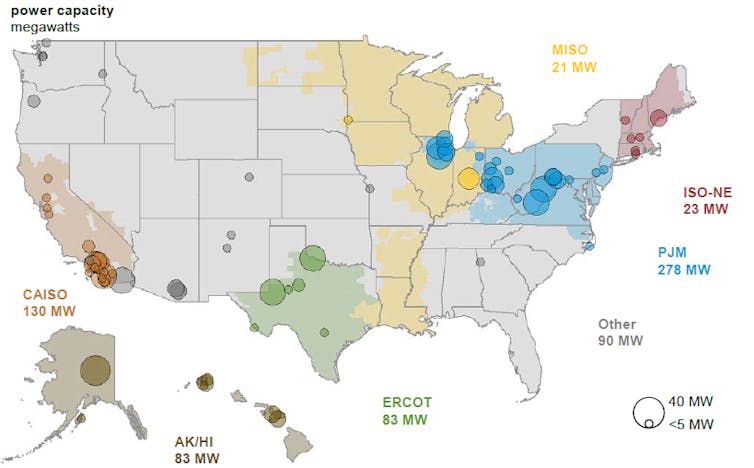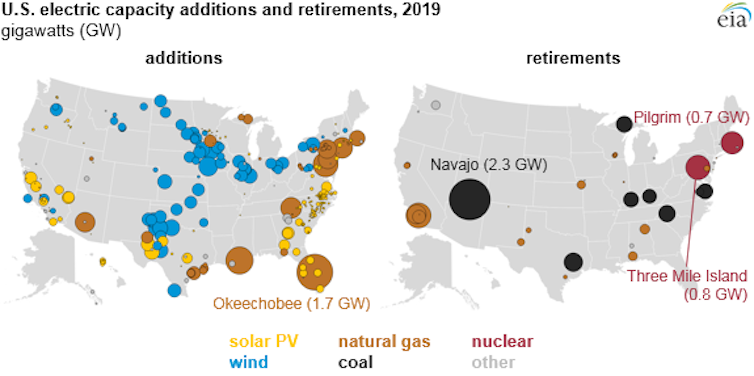This article focuses on lithium ion batteries but there are a couple other battery technologies that work for large scale uses that don't work for vehicle applications, see links below.
Additionally the use of ammonia (for the hydrogen) as an energy storage medium is being persued by some very big players, Yara, Siemens, and the U.S. ARPA-E researchers to name just three.
And as Australia is finding out with their giant Tesla lithium battery, the things don't work so well in extreme heat. Ditto for extreme cold as the owners of electric vehicles found during the recent polar vortex experience.
From The Conversation:
Utilities are starting to invest in big batteries instead of building new power plants
Due to their decreasing costs, lithium-ion batteries now dominate a range of applications including electric vehicles, computers and consumer electronics.
You might only think about energy storage when your laptop or cellphone are running out of juice, but utilities can plug bigger versions into the electric grid. And thanks to rapidly declining lithium-ion battery prices, using energy storage to stretch electricity generation capacity.
Based on our research on energy storage costs and performance in North Carolina, and our analysis of the potential role energy storage could play within the coming years, we believe that utilities should prepare for the advent of cheap grid-scale batteries and develop flexible, long-term plans that will save consumers money.
All of the new utility-scale
electricity capacity coming online in the U.S. in 2019 will be generated
through natural gas,
wind and solar power as coal, nuclear and some gas
plants close.
U.S. Energy Information Administration
Peak demand is priceyThe amount of electricity consumers use varies according to the time of day and between weekdays and weekends, as well as seasonally and annually as everyone goes about their business.
Those variations can be huge.
For example, the times when consumers use the most electricity in many regions is nearly double the average amount of power they typically consume. Utilities often meet peak demand by building power plants that run on natural gas, due to their lower construction costs and ability to operate when they are needed.
However, it’s expensive and inefficient to build these power plants just to meet demand in those peak hours. It’s like purchasing a large van that you will only use for the three days a year when your brother and his three kids visit.
The grid requires power supplied right when it is needed, and usage varies considerably throughout the day. When grid-connected batteries help supply enough electricity to meet demand, utilities don’t have to build as many power plants and transmission lines.
Given how long this infrastructure lasts and how rapidly battery costs are dropping, utilities now face new long-term planning challenges.

Grid-scale batteries are being
installed coast-to-coast as this snapshot from 2017 indicates.
Source:
U.S. Energy Information Administration, U.S. Battery Storage Market
Trends, 2018.
Cheaper batteries...MORE
About half of the new generation capacity built in the U.S. annually since 2014 has come from solar, wind or other renewable sources. Natural gas plants make up the much of the rest but in the future, that industry may need to compete with energy storage for market share....
A few of our hundreds of battery posts. Please note the intro to the first post on carbon based batteries, we've been doing this a long time and have learned a few things:
Look Mom, No Lithium! (Proton Batteries)
We post on very, very few battery technologies/breakthroughs/discoveries because:
1) There are so many we'd never get any actual work done. The potential rewards are so huge that everybody-and-their-brother-in-law is trying to find the Holy Grail.Electricity: Cali. Billionaire Says He Has the Answer For Cheaper Grid Storage
2) 98% of the announcements will result in nothing outside the laboratory, the stuff just won't scale up....
Batteries: Lithium-Iron may be Competitive With Lithium-Cobalt
"Ten years left to redesign lithium-ion batteries"
Electric Vehicles: An Old Pro On Battery Technology and Policy and China
And on a different approach to storing and transporting energy:
This Could Be A Big Deal: Norway's Yara and the Australian Nitrogen Economy
Shipping: "UK Department of Transport recommends launch of ammonia / hydrogen powered vessels within 5-15 years"
